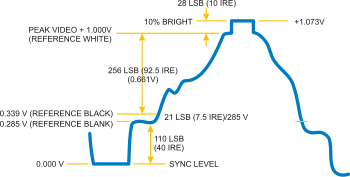
IRE (unit)
Encyclopedia

Composite video
Composite video is the format of an analog television signal before it is combined with a sound signal and modulated onto an RF carrier. In contrast to component video it contains all required video information, including colors in a single line-level signal...
signals. Its name is derived from the initials of the Institute of Radio Engineers
Institute of Radio Engineers
The Institute of Radio Engineers was a professional organization which existed from 1912 until January 1, 1963, when it merged with the American Institute of Electrical Engineers to form the Institute of Electrical and Electronics Engineers .-Founding:Following several attempts to form a...
.
A value of 100 IRE was originally defined to be the range from black to white in a video signal. A value of 0 IRE corresponds to the zero voltage value during the blanking period. The sync pulse is normally 40 IRE below the zero value, so, peak to peak, an all white signal should be equal to 140 IRE.
The reason IRE is a relative measurement (percent) is because a video signal may be any amplitude. This unit is used in the ITU-R BT.470 which defines PAL
PAL
PAL, short for Phase Alternating Line, is an analogue television colour encoding system used in broadcast television systems in many countries. Other common analogue television systems are NTSC and SECAM. This page primarily discusses the PAL colour encoding system...
, NTSC
NTSC
NTSC, named for the National Television System Committee, is the analog television system that is used in most of North America, most of South America , Burma, South Korea, Taiwan, Japan, the Philippines, and some Pacific island nations and territories .Most countries using the NTSC standard, as...
and SECAM
SECAM
SECAM, also written SÉCAM , is an analog color television system first used in France....
.

